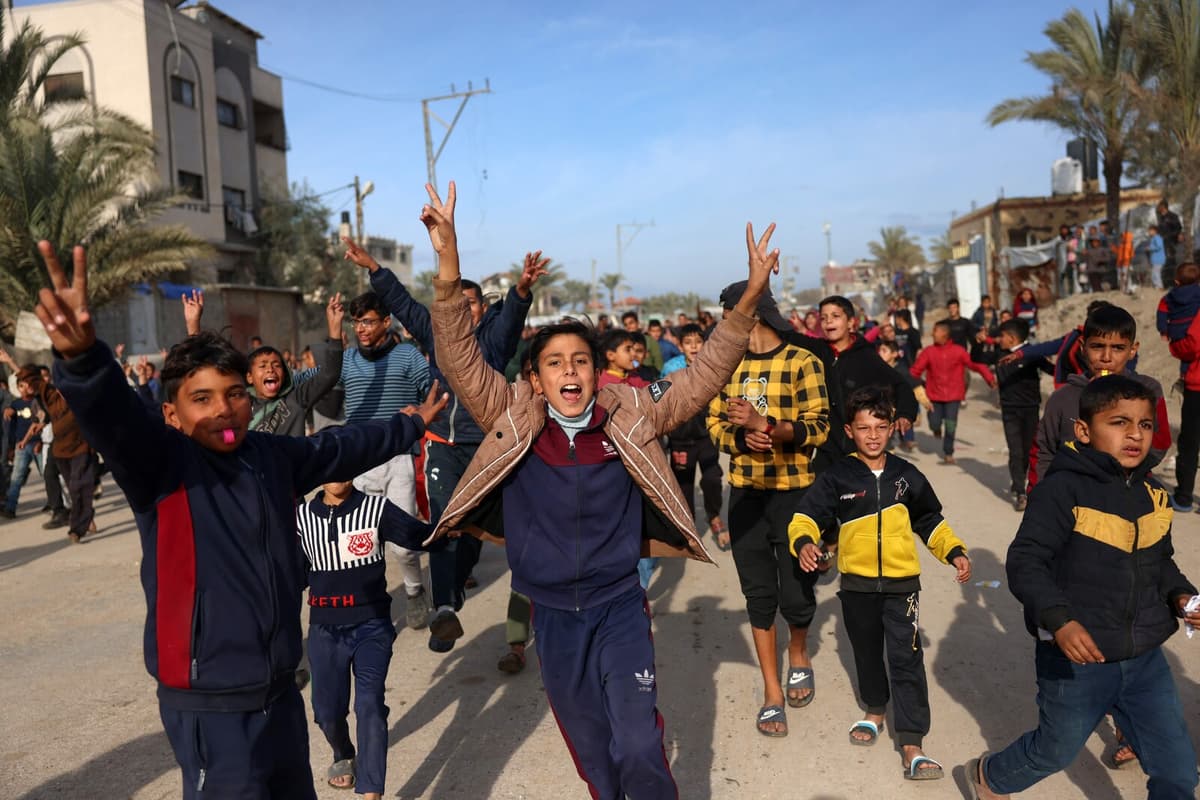After 15 months of war, the ceasefire finally came into effect at 10:15 am on Sunday morning Swedish time. Thousands of Gazans began to move north from areas in the southern part of the strip where they had sought shelter.
At the border, the first trucks with humanitarian aid have started to roll in to the largely destroyed Gaza.
Families who had been on the run began to head home on foot, with their belongings loaded onto donkeys, while they could still hear Israeli tanks firing.
People are impatient. They want this madness to end, said Ahmed Matter, a resident of Gaza City.
The Ceasefire Was Delayed
Jubilant scenes unfolded in the city of Dayr al-Balah in central Gaza as early as 7:30 am Swedish time, when the ceasefire was supposed to take effect. Many took pictures with their phones, others made victory signs, clapped their hands, and hugged each other in the belief that the violence had stopped.
But the ceasefire's entry into force had been delayed because Hamas had not submitted a list to Israel of the persons in captivity who were to be released according to the agreement.
The terrorist-stamped Islamist movement confirmed that the lists were delayed due to "technical problems".
While waiting for the list, the Israeli army resumed attacks on "terrorist targets" in northern and central Gaza with artillery and fighter jets. According to reports from Hamas-controlled authorities, 19 people were killed and dozens more injured, reports the Israeli newspaper Haaretz.
In Gaza City, the Hamas-controlled civil defense held a parade where rescue workers waved Palestinian flags. Masked militiamen were also seen in the crowds, where other groups of people sang songs to praise them.
"Attack Again"
In Israel, people hoped that more people would be able to come home from Hamas captivity. They were taken away when Israel was attacked on October 7, 2023.
Asher Pizem, 35, from the Israeli city of Sderot near Gaza, was one of those who hoped. However, he is divided about the ceasefire agreement, which he believes will only postpone the next confrontation with Hamas.
They will bide their time and attack again, he says to AP, while gazing out at the smoking ruins in Gaza on the other side of the border.
Later in the afternoon, three Hamas captives are expected to be released. They are three women, 31, 28, and 24 years old. Two of them were taken from a kibbutz, while the third was kidnapped from the Nova music festival during Hamas's large-scale attack on Israel on October 7, 2023.
After the three releases, another 30 will follow in stages. In exchange, Israel will release, among others, hundreds of Palestinians imprisoned in Israeli prisons.
Terrorist-stamped Hamas attacked Israel on October 7, 2023
Around 250 people, mostly Israelis, were taken as hostages and brought to Gaza.
During a ceasefire in November 2023, over 100 hostages were exchanged for 240 Palestinian prisoners.
Several more Israelis have been freed by the country's military.
Currently, it is estimated that around 100 hostages remain in Gaza. But it is unclear how many of them are still alive.
More than 46,800 Palestinians in the Gaza Strip have been killed since the start of the war, according to health authorities in Hamas-controlled Gaza.
During the same period, nearly 1,600 Israelis have been killed, around 1,200 of them during the October 7 attack, according to Israeli authorities.
Almost the entire population of Gaza is on the run within the strip's borders, according to UN estimates.
Large parts of Gaza's infrastructure lie in ruins.
Phase One
Lasts for six weeks
Hamas will release 33 Israeli hostages
Israel will release over 730 Palestinians from Israeli prisons, as well as over 1,100 who have been detained by the military in Gaza within the framework of the war.
Israel will make some initial military withdrawals from key areas in Gaza.
Much more aid and supplies will be allowed into the population.
Negotiations on the forms of the next phase will begin.
Phase Two
Hamas will release all remaining hostages who are still alive.
Israel will release more imprisoned Palestinians.
The Israeli military will begin a full withdrawal.
Phase Three
Hamas will hand over the remains of dead hostages.
A three-to-five-year reconstruction of destroyed Gaza will begin under international supervision.
Border crossings to the area will be opened.





